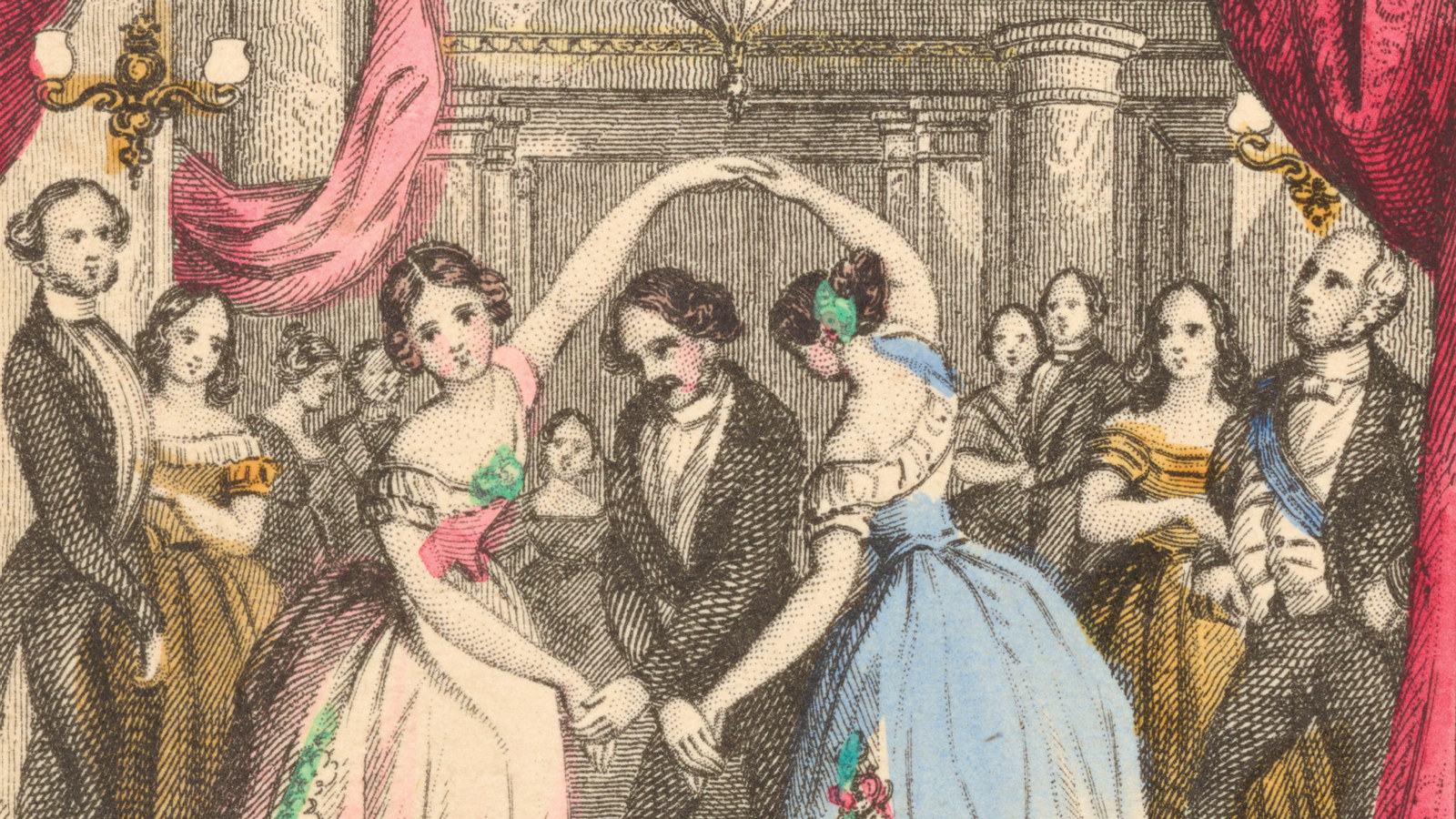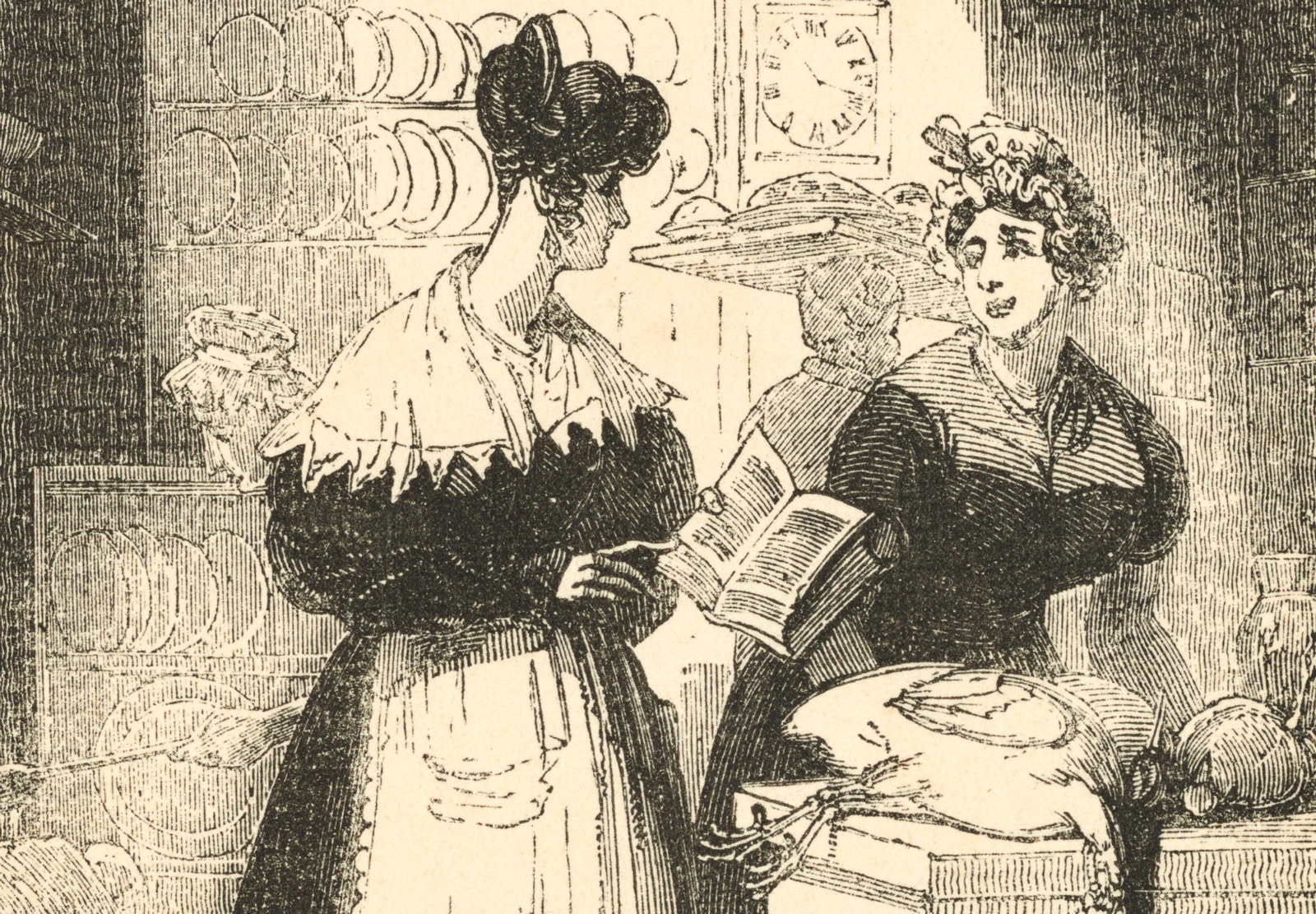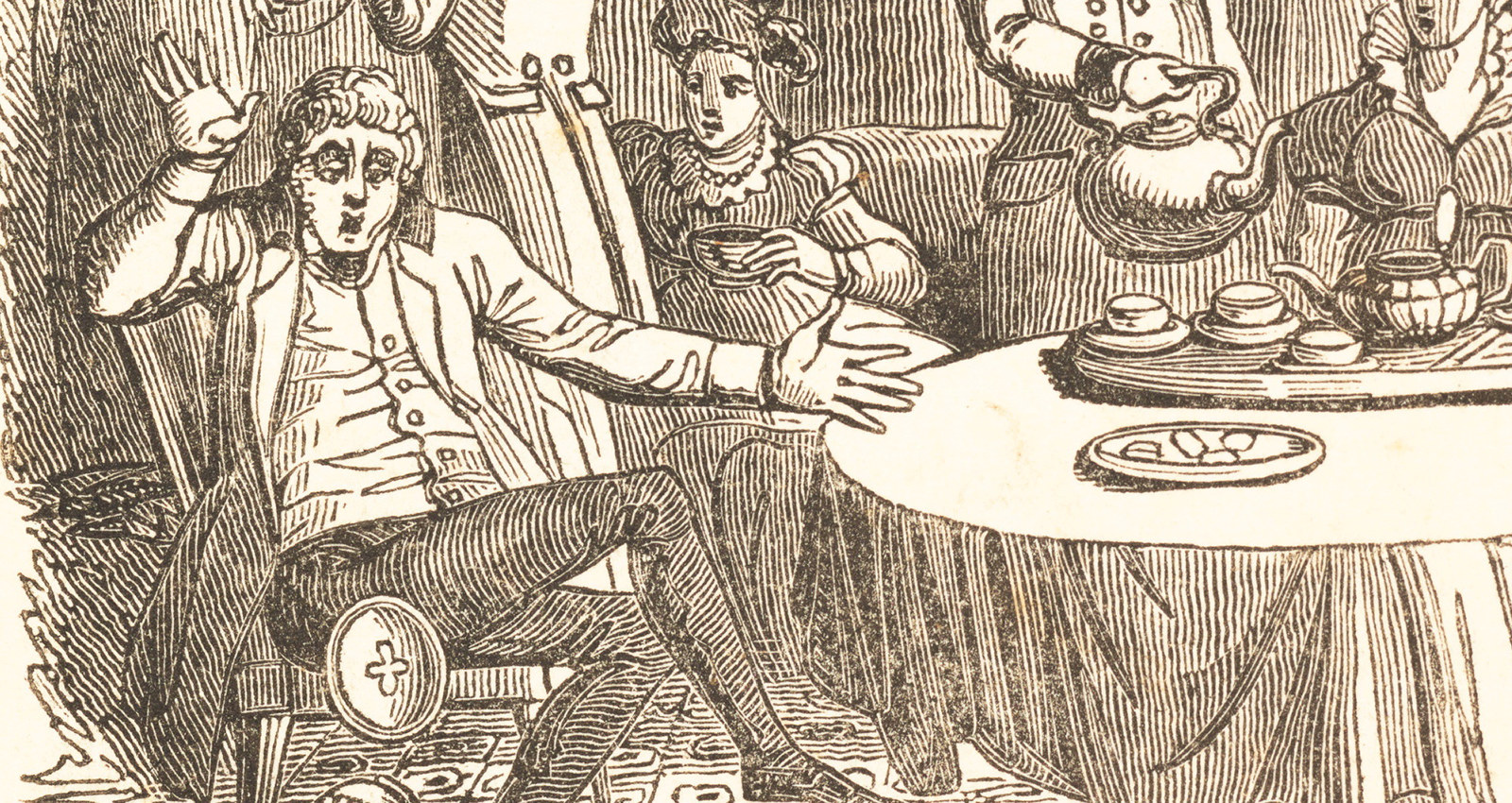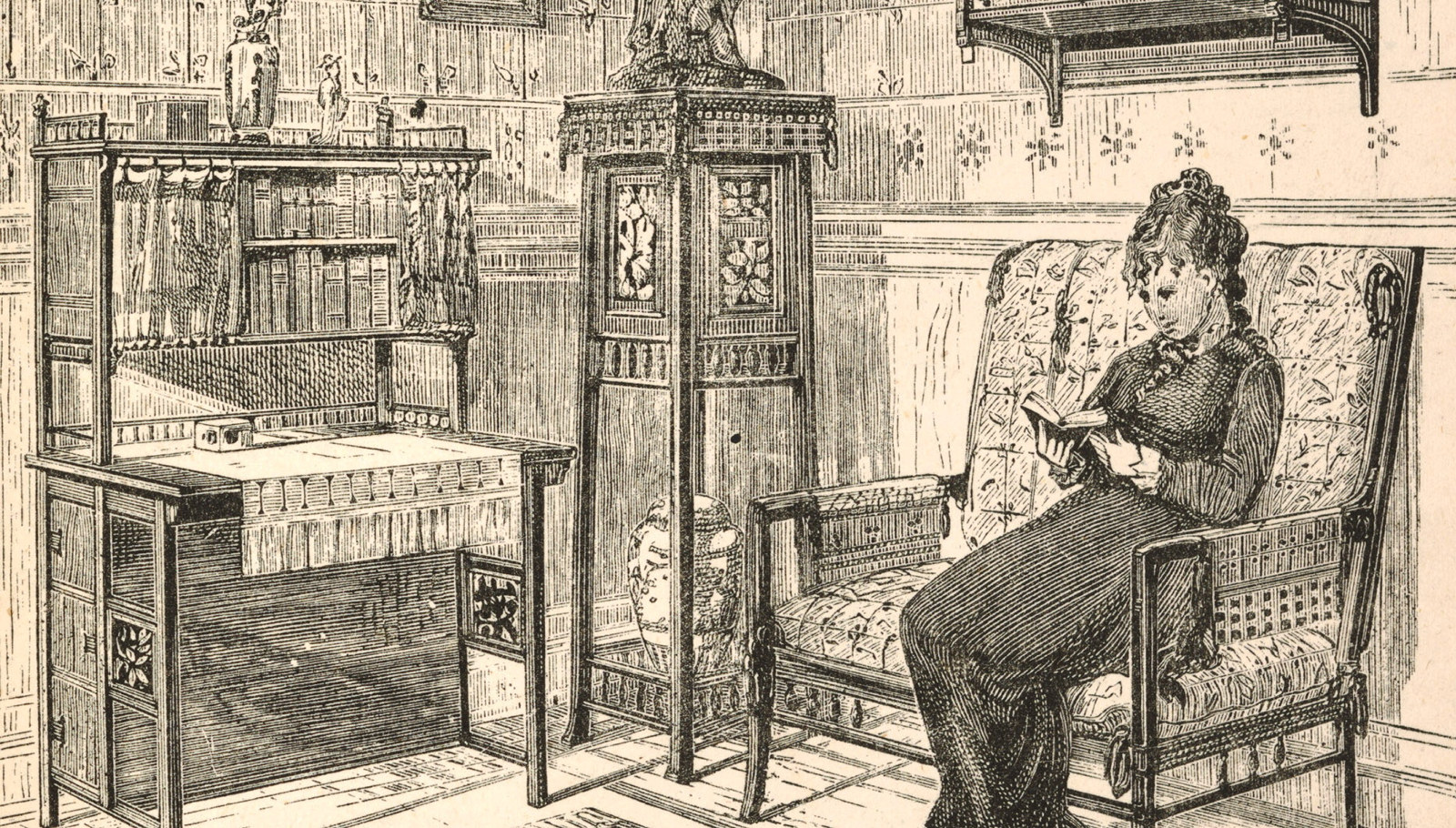Guides for domestic economy
19th Century Domestic Advice Manuals
In the fields of domestic economy, readership comprised chiefly young married women.
Manuals informed the ‘house-wife’ on a woman’s role within the domestic sphere: how to be domestically capable, make a comfortable home and live within one’s means. Manuals presented the kitchen as a suitable place for middle-class women to develop skills and managerial proficiency as a key to their role as ‘mistress of the house’.
The Female Instructor
The female instructor; or, young woman’s companion: being a guide to all the accomplishments which adorn the female character, either as a useful member of society – a pleasing and instructive companion or, a respectable mother of a family, Liverpool: Nuttall, Fisher and Dixon, 1815.
This early advice manual is aimed largely at literate young women from ‘middling’ backgrounds. The writing is idealistic in nature and moral in tone - a format previously used in 18th century women’s literature - to translate Christian values into household terms.
The female instructor promotes the need for piety, cleanliness, neatness of dress, modesty, sweetness of temper, industry, sobriety and frugality as the distinguishing virtues of ‘respectable’ women.
... to unite in the female character, cultivation of talents and habits of economy and usefulness; particularly domestic habits.
[p.iii]
Liverpool publishers Nuttall, Fisher & Dixon, were founded in 1810 by printer Jonah Nuttall (1760-1837). The firm became one of the largest printing works in Britain and published works including dictionaries, poetry, handbooks and manuals, devotional literature, history and biographies.
Practical Economy
Practical economy, or, the application of modern discoveries to the purposes of domestic life, second edition, London: Henry Colburn & Co., 1822.
Practical economy differs from the majority of domestic economy manuals, which target the house-wife. Aimed at both the master and mistress of the house, it offers advice to ‘the higher and middle ranks of life ... most particularly to the class of absentees ..... that voluntary exiles might find comfort and respectability living abroad on moderate income...' [p.v ]
Chapters are devoted to subjects such as location of land and position of dwelling; the natural and human resources required to establish a healthy, functioning and productive dwelling and estate; the human resources necessary to maintain a comfortable life; and the organisation and fit-out of internal and external spaces.
English born banker and pastoralist John Leake (1780-1865) arrived in the colony and goal settlement of Hobart Town aboard theAndromeda in 1823. He was accompanied by wife Elizabeth, nee Bell (1786-1852), members of his family and two servants. As a free settler, Leake was granted 500 acres (202ha) of land on the Macquarie River, near Campbell Town. An additional 2000 acres (809ha) in 1825 formed the estate of ‘Rosedale’. As a free colonist, Leake was assigned convict labour for use as house servants, builders and farm-hands. A large stone villa was built in the Italianate style - designed by colonial architect James Blackburn (1893-1854). Leake’s income was initially from banking and later from the merino sheep he brought from Saxony and developed on the estate.
The Housekeeper's Oracle
William Kitchiner, The housekeeper’s oracle: or, art of domestic management: containing a complete system of carving with accuracy and elegance; hints relative to dinner parties; the art of managing servants; and the economist and epicure’s calendar, shewing the seasons when all kinds of meat, fish, poultry, game, vegetables and fruits, first arrive in the market etc., London: Whitaker, Treacher, and Co., 1829.
The housekeeper’s oracle was written as a companion work to Kitchiner’s earlier The cook’s oracle (1817). Unlike the first, this volume is aimed at young housewives
To supply information to young persons of all classes … the object to guard young housewives against impositions – of dishonest servants, or extortions of – extravagant tradespeople …
[preface]
The manual contains tables of fruits, vegetables, seafoods and meats and calendars indicating seasonal availability and pricing. Advice is also given on the duties of a ‘wife and mother’ and the most efficient methods of making and running a ‘comfortable’ house. There is also a table for candle prices. The back of the book contains common household recipes and remedies.
Author William Kitchiner M.D. (1775–1827), son of a London coal merchant, was best known as a skilled cook and cookery writer. He wrote of, and created, a portable traveling case of ingredients which included liqueurs, spice blends and proprietary sauces, known as his ‘cabinet of taste’. Kitchiner also set up a ‘Committee of Taste’, comprised of like-minded members who held weekly meetings and took turns to host fashionable dinners. His highly successful cookbook, The Cook's Oracle, provided inspiration for authors such as Mrs Beeton, who later in the century used a number of the recipes in her publications.
The House Book
Eliza Leslie, The house book: or, a manual of domestic economy, Philadelphia: Carey & Hart, 1840.
The house book was published as a companion to Miss Leslie’s Directions for cookery (1837) and was aimed at young wives who require guidance on how to establish a home. The book stresses the need for the mistress of the house to have a thorough understanding of the home as a ‘functioning system’. It includes information on fittings, fixtures and furnishings required for different rooms and gives explicit instructions on how to perform basic, everyday household tasks, such as how to make a laundry bag or how to build and light a fire.
Philadelphia born Eliza Leslie (1787–1858) was an author of cookbooks, books on household management and etiquette, novels, short stories and articles for magazines and newspapers. Leslie’s works were aimed at all classes and tailored for a developing American identity, in a market dominated by British publications. Leslie studied at Mrs Goodfellow’s cooking school in Philadelphia in the early 1820s and used recipes learnt there for her first publication Seventy-five receipts for pastry, cakes and sweetmeats, by ‘a Lady of Philadelphia’ (1828).
… to impart to novices in house-keeping some information on a subject which is, or ought to be, important to every American female, so that they may be enabled to instruct unpractised domestics, or, in case of emergency, to assist personally in forwarding the indispensable work of the family.
[p.3]
Leslie also edited The gift: a Christmas and new year’s present (1837), which included early publications by Edgar Allan Poe, as well as her own magazine of literature and fashion, Miss Leslie’s Magazine. She also wrote a novel in 1848 titled Amelia; or a young lady’s vicissitudes. Her humorous writing style and knowledge made her books popular for many years - the extremely successful Directions for cookery, in its various branches, published in 1837, continued to be printed into the 1890s.
The publishing business of Carey & Hart was founded in Philadelphia, Pennsylvania in 1829. The firm specialised in the publication of regional writing and ‘frontier humour’. It also published notable authors such as Henry Wadsworth Longfellow and William Cullen Bryant and in the absence of foreign copyright laws, were the first to release Jane Austen’s Pride and prejudice in America.
A Treatise on Domestic Economy
Catherine E. Beecher, A treatise on domestic economy, for the use of young ladies at home, and at school, revised [third] edition, New York: Harper & Brothers, 1845.
A treatise on domestic economy was designed to be used as a textbook in female schools. The work was accepted by the Massachusetts Board of Education and admitted as part of the Massachusetts School Library. Dedicated to ‘American Mothers’, the manual promotes education as being central to women’s roles as mothers and teachers, and their influence on the next generation.
… young girls, especially in the more wealthy classes, are not trained for their profession… they enter on their most arduous and sacred duties so inexperienced and uninformed …
[preface]
Chapters include headings such as ‘Peculiar responsibilities of American women’ and ‘Difficulties peculiar to American women’. The work also discusses health and diet, clothing, cleanliness, ‘Manners and habits’, ‘System and order’, charity, ‘Economy of time and expenses’, housekeeping, household management, ‘Propagation of plants’, ‘Cultivation of fruits’ and ‘Animal husbandry’.
Catharine Esther Beecher (1800-1878) was the daughter of Presbyterian minister and evangelist Lyman Beecher and wife Roxana Foote. After the death of her husband Professor Alexander Fisher, Catherine devoted her life to education. In 1823, she and sister Mary Foot Beecher Perkins (1805-1900) founded the Hartford Female Seminary. The school offered a range of subjects, including physical education and calisthenics to improve women’s health. Catherine also released The duty of American women to their country (1845), Miss Beecher's domestic receipt book: designed as a supplement to her treatise on domestic economy (1846) and The American woman’s home (1869) with sister, Harriet Beecher Stowe (1811-1896).
New York publisher Harper & Brothers was established in 1817 by James (1795–1869) and John Harper (1797–1875). They were joined by brothers Wesley (1801–1870) and Fletcher (1806–1877) in 1833. The firm released Harper's New Monthly Magazine and Harper's Weekly in the 1850s and, after the US Civil War (1861-1865), published their own textbooks, trade books and periodicals. Harper & Brothers merged with Row, Peterson & Company in 1962, becoming Harper & Row and then HarperCollins.
Home Truths for Home Peace
MBH, Home truths for home peace, or “Muddle” defeated; a practical inquiry onto what chiefly mars or makes the comfort of domestic life, sixth edition, London: Longman, Brown, Green, and Longmans, 1854.
… to the young wives and housewives of the middle classes; this attempt at the exposure and destruction of their most insidious and deadly enemy …
[preface]
Home truths was first published in 1851 by anonymous female author MBH. This satirical work has chapters divided into three sections, ‘Part I. - Muddle detected’, ‘Interlude – Muddle of order’ and ‘Part II. - Muddle defeated’.The manual provides instruction on the management techniques required for an ‘ordered and efficient home’. It advises the reader to accept interruption to routine as a function of a house-wife’s position in the middle-class household and warns against the ‘potential for household anarchy’.
London publisher Longman, Brown, Green, and Longmans was originally founded by Thomas Longman (1699-1755) in 1724. On his death, nephew Thomas Longman took over and expanded the firm’s colonial trade. The business was eventually acquired in 1968 by global publisher Pearson, owner of Penguin and The Financial Times, but remained in family control until 1972. Longman continued to exist as an imprint of Pearson, under the name Pearson Longman, but is now primarily used by Pearson's ELT (English Language Teaching) business.
The Frugal Housewife
Mrs Child, The frugal housewife. Dedicated to those who are not ashamed of economy, 24th ed., London: William Tegg, 1860.
The frugal housewife is a manual which advises young wives on their approach to domestic management. This is done through anecdotal stories of failure - tales of extravagance, lack of virtue and failure to monitor costs due to ‘false pride or foolish ambition’.
They who never reserve a farthing of their income, with which to meet any unforeseen calamity, “pay too dear for the whistle”, whatever temporary benefits they may receive from society.
[p.4.]
Chapters include ‘Odd scraps for the economical’, ‘Observations on certain articles’, ‘Common cooking’, ‘Rural economy’ and ‘Hints to persons of moderate fortune’.
American author Lydia Maria Francis Child (1802 – 1880), was an abolitionist, women’s rights activist, novelist and journalist. Her domestic manuals gained wide readership from the 1820s and her most successful work was The frugal housewife. First published in 1829, the book was released in a further thirty-three editions over a 25-year period. Aimed at working-class women, Child references experiences in Boston and speaks of the sacrifices made by the working-classes for the benefit of the rich. Taking a strong position on the burden worn particularly by disadvantaged women, Child advocates religion and education as the primary means to create ‘wealth from toil’ and end ‘disgrace and poverty’.
... the situation and prospects of the country may be justly estimated by the character of its women ...folly follows for generations if girls fail to marry or become efficient in the home.
[p.147.]
London publisher William Tegg (1816–1895) started in his father's business, then ran operations from 1845 until retirement in 1890. A publisher of the reprint and remainder trade, Tegg based the business on affordable editions targeted at the working or lower middle-classes.
The Household
The household: a book of reference upon subjects relating to domestic economy and home enjoyment, London: Groombridge and Sons, 1866.
London publisher Richard Groombridge started business around 1832. He acquired premises in Paternoster Row in the early 1840s and took on sons Richard Coleman, Henry, William and Charles as apprentices. From 1845 the firm traded as Groombridge and Sons and went on to publish The Family Economist: a penny monthly magazine, devoted to the moral, physical, and domestic improvement of the industrious classes (1848).
Practical Housekeeping
Mrs Pedley, Practical housekeeping or the duties of a home-wife, London: George Routledge and Sons, 1867.
Practical housekeeping ‘… bears reference to wives who are their own house-keeper ... ‘. It offers guidance to middle-class women on how to create an efficient, healthy and comfortable home on a budget. Chapters I – XVI provide advice on choosing dwellings for economic and health benefits, instructions on how to make homes convenient, practical and comfortable, and guidance on the selection, purchase and preparation of foods. Chapters XVII – XXVI comprise information regarding servants – their hierarchy, duties, dress, wages, and dismissal.
Increasing employment opportunities for the working-classes, in areas beyond domestic service, resulted in difficulty for middle-class households to recruit or afford servants. By mid-century, domestic work therefore fell increasingly to housewives, with the assistance of possibly one servant.
To keep pace with times, and enjoy new pleasures, is the desire of every class … the demand for servants is so great that they leave situations on the slightest provocation … to remedy these defects is plainly the work of women …-
[pref]
English author Mrs. Pedley also wrote Infant nursing and the management of young children, [1866]. Publisher George Routledge (1812–1888) traded under the name of George Routledge & Sons from 1858 to 1865, with sons Robert Warne, and Edmund (1843–1899).
Book of Family Management
The book of family management: a practical cyclopedia of useful knowledge. Containing what it is important to know on the essentials of home economy, Manchester: J. W. Shaw, [c.1886].
The book of family management was originally released in 1886 by London publisher Ward Lock & Co. as Sylvia's family management, a book of thrift and cottage economy. This edition was released shortly after and offers advice to both experienced and novice housewives on the management of house and family.
The work includes 350 monochrome and colour plate illustrations and covers a comprehensive range of subjects. These include advice to housekeepers, mistresses and servants; thrift and economy; acquiring and keeping a home; management; selection and preparation of food; medical advice; family law; etiquette and letter-writing; dress; needlework and care of animals.
The Caroline Simpson Library & Research Collection also holds Sylvia's book of macrame lace, originally published as the fourth book of The lady's handbook of fancy needlework [1882].
Published on
19th Century Domestic Advice Manuals

Eat, pray, decorate
Advice manuals – the self-help books of the 19th century – provide a rich source of information about domestic and social life in the era

Guides for masters and mistresses
Advice manuals in this category may on the surface appear paradoxical. The works provide ready reference on the varied duties of male and female domestic service roles

